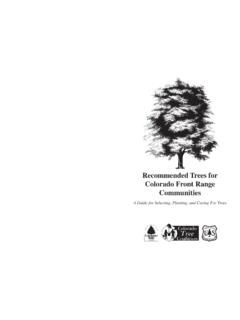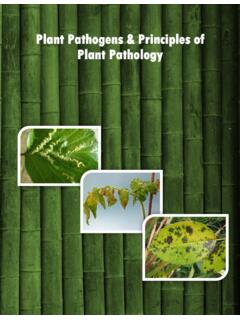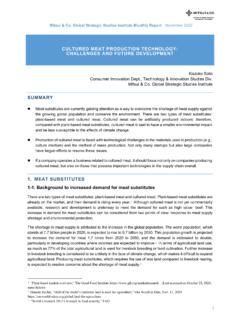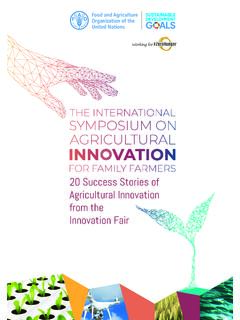Transcription of Tree Planting Steps - Colorado State University
1 Colorado Master Gardenersm Program Colorado Gardener Certificate Training Colorado State University Extension CMG GardenNotes #636. Tree Planting Steps This publication summarizes the tree- Planting process. Linden, Poplar, Red Maple, and other species For an in-depth discussion on tree Planting , refer to CMG with aggressive root systems), the top structural GardenNotes #633, The Science of Planting Trees. root should be within the top one inch of the root ball. The science of Planting trees is aimed at promoting rapid root growth (regeneration) to quickly reduce the water stress imposed by the harvest and Planting Checking depth of tree in root ball Check depth process. Post- Planting stress (transplant shock) consists of the tree in the root ball. Do not assume that it was of the stress factors induced by the reduced root system. planted correctly at the nursery. Planting trees too deeply has become an epidemic leading The presence of the root flare is an indication of to the decline and death of landscape trees.
2 In the good Planting depth. However, small trees may landscape, trunk-girdling roots account for 57% of all tree have minimal root flare development making it deaths. Trunk-girdling roots develop when a tree is difficult to determine. Be careful not to mistake planted too deeply in the root ball and/or the root ball is swelling of the trunk below the graft as the root planted too deeply in the Planting hole. Trunk-girdling roots may lead to decline and death some 12 to 20 years flare. after Planting . Trunk-girdling roots may be below ground. A good way to evaluate Planting depth in the root ball is with a slender implement like a slender screwdriver, knitting needle or barbeque skewer. Systematically probe the root ball 3-4 inches out Step 1. from the trunk to locate structural roots and Determine the depth of the Planting determine depth. [Figure 1]. hole Figure 1. Systematically probe the root ball with a slender screwdriver.
3 Depth of root ball in Planting hole Generally, at least two structural roots should be found in the top 1-3 inches of soil, 3-4 inches out from the trunk. On To deal with the soil texture interface (differences in species prone to trunk-circling roots, soil pore space) between the root-ball soil and the top structural root should be within backfill soil, it is imperative that the root ball rise the top one inch of the root ball. slightly above grade with no backfill soil over top of the root ball. For small (one-inch caliper) trees, the top of the root ball should be about one inch above If the tree is planted too deeply in the root ball, grade. For larger (2-4 inch caliper) trees, the top of excess soil should be removed from the top in the the root ball should be about two inches above grade. backfill step of the Planting process. Adjust the Backfill soil should cover the knees, tapering down depth of the Planting hole to compensate.
4 [Figure 2]. to grade. [Figure 6]. Excess soil should be Depth of tree in the root ball removed during the backfill process. Generally, at least two structural roots should be within the top 1-3 inches of the root ball, measured 3-4 inches from the trunk. Figure 2. Adjust the depth of the Planting hole to bring the On species prone to trunk-circling roots root flare to the correct depth. (Crabapples, Green Ash, Hackberry, Littleleaf 636-1. The depth of the Planting hole should be 1-2 Vertically align the tree, with the top centered above inches less than the height of the root ball. the root ball. Due to curves along the trunk, the trunk However, Planting hole depth may need to be may not necessarily look straight. It will appear adjusted to correct the depth of the tree in the straighter with growth . root ball. In this step, techniques vary for Container-Grown Trees and Balled And Burlapped (B&B) Trees.)
5 Step 2. Dig a saucer-shaped Planting hole three times the root ball diameter Container-Grown Nursery Stock o To maximize soil oxygen levels the top of the Container-grown nursery stock describes a variety root ball rises 1-2 inches above grade (adjusted of production methods where the trees or shrubs are for proper rooting depth as determined in step 1). grown in containers (limiting root spread to the size o The root ball sits on undug soil, stabilizing the of the container). In some systems, like pot-in-pot . tree and preventing sinking and tilting. and grow-bags, the container is in the ground. An o A saucer-shaped Planting hole three times the advantage of container stock is that it can be planted root ball diameter with sloping sides allows the in spring, summer, or fall. root system to grow rapidly to 400% of the root ball volume before being slowed by the lower Actual Planting techniques in this step vary with the oxygen levels in the site soil.
6 This is enough to type of container and extent of root development. minimize post- Planting stress in normal Planting Generic Steps include: situations. o The wide, saucer-shaped Planting hole gives the a) Lay the tree on its side in or near the Planting tree more tolerance to over-watering problems hole. and waterlogged soils. b) Wiggle off or cut off the container. o The wide Planting hole allows for root ball c) Shave off the outer 1-1 inches of the root wrappings to be removed after the tree is situated ball with a pruning saw or pruners. This is to in the Planting hole. deal with circling roots. o A labor-saving technique is to dig the Planting d) Tilt the tree into place with the inside curve hole about two times the root ball diameter with of any graft crook facing north. somewhat vertical sides, then widen the hole into e) Check the depth of the root ball in the the desired saucer shape with the shovel during Planting hole.
7 If needed, remove the tree and the backfill process. [Figure 3] correct the hole depth. f) Align vertically. g) For stability, firm a shallow ring of soil around the bottom of the root ball. [Figure 5]. Figure 3. A labor-saving technique is to widen the o The ideal container-grown tree has a nice Planting hole into the desired saucer shape, three times network of roots holding the root ball together. the root ball diameter during the during backfill process. After the container is removed, the tree is gently tilted into place. o If most of the soil falls off the roots, the tree is Step 3. Set the tree in place, removing planted as a bare-root tree. container/wrappings o If some of the soil falls off (often on the bottom), it may be necessary to adjust the depth of the In setting the tree into the Planting hole, if the tree Planting hole. Backfill and pack the bottom of has a "dogleg" (a slight curve in the trunk just above the Planting hole to the correct depth.
8 The graft) the inside curve must face north to avoid o Fabric grow bags must be removed from the winter bark injury. [Figure 4]. sides. They are generally cut away after setting the tree into place. Figure 4. The inside curve of the graft crook o Generally, paper/pulp containers should be or "dogleg" must go to the north to avoid winter bark injury. removed. Most are slow to decompose and will complicate soil texture interface issues. Pulp 636-2. containers often need to be cut off, as they may not slide off readily. Figure 5. Stabilize the tree by o In handling large trees (3-inch caliper and firming a small ring of backfill soil greater) it may be necessary to set the tree into around the base of the root ball place before removing the container. f) Removed all the wrapping (burlap, fabric, Field-Grown, B&B Nursery Stock twine, wire basket, etc.) on the upper 12. inches or upper 2/3 of the root ball, Field-grown, balled and burlapped (B&B) trees and whichever is greater.
9 Shrubs are dug from the growing field with the root g) If roots are found circling the root ball, shave ball soil intact. In the harvest process, only 5-20% of off the outer 1-1 inches of the root ball the feeder roots are retained in the root ball. B&B with a pruning saw or pruners. nursery stock is best transplanted in the cooler spring or fall season. The consensus from research is clear that leaving burlap, twine, and wire baskets on the sides of the To prevent the root ball from breaking, the roots are root ball is not an acceptable Planting technique. balled and wrapped with burlap (or other fabrics) and twine (hence the name B&B). In nurseries today, o Burlap may be slow to decompose and will there are many variations to the B&B technique. complicate soil texture interface issues. Some are also wrapped in plastic shrink-wrap, placed o Burlap that comes to the surface wicks moisture into a wire basket, or placed into a pot.
10 From the root ball, leading to dry soils. o Jute twine left around the trunk will be slow to An advantage of the wider Planting hole is that it decompose, often girdling the tree. gives room for the planter to remove root ball o Nylon twine never decomposes in the soil, often wrappings AFTER the tree is situated in the hole. girdling the tree several years after Planting . o Wire baskets take 30-plus years to decompose Based on research, standard procedures are to and interfere with long-term root growth . remove root ball wrapping materials (burlap, o Some planters find it easier to cut off the bottom fabric, grow bags, twine, ties, wire basket, etc.) of a tapered wire basket before setting the tree from the upper 12 inches or 2/3 of the root ball, into the hole. The basket can still be used to help whichever is greater, AFTER the tree is set into move the tree and is then easy to remove by place.








